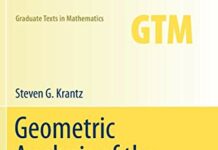
Ebook Info
- Published: 1996
- Number of pages: 465 pages
- Format: PDF
- File Size: 24.10 MB
- Authors: Steven G. Krantz
Description
Winner of the CHOICE Outstanding Academic Book Award for 1997! The purpose of this book is to teach the basic principles of problem solving, including both mathematical and nonmathematical problems. This book will help students to … translate verbal discussions into analytical data. learn problem-solving methods for attacking collections of analytical questions or data. build a personal arsenal of internalized problem-solving techniques and solutions. become “armed problem solvers”, ready to do battle with a variety of puzzles in different areas of life. Taking a direct and practical approach to the subject matter, Krantz’s book stands apart from others like it in that it incorporates exercises throughout the text. After many solved problems are given, a “Challenge Problem” is presented. Additional problems are included for readers to tackle at the end of each chapter. There are more than 350 problems in all. This book won the CHOICE Outstanding Academic Book Award for 1997. A Solutions Manual to most end-of-chapter exercises is available.
User’s Reviews
Editorial Reviews: Review “Krantz has collected a thoroughly engaging arsenal of problems and problem-solving techniques. Most scientists will want to have a copy for personal reference and for the mental stimulation that it provides. It is well written in a style that encourages the reader to become actively involved … a myriad of fascinating related problems are provided. After a delightful introductory chapter, the chapters are primarily organized around specific techniques and their applicability in areas such as geometry, logic, recreational math, and counting. The book is written in a linear fashion that makes it advisable to tackle problems in sequential order … would be an excellent tool for teaching novices to read some mathematics.” —- CHOICE Magazine”The book will help students to: translate verbal discussions into analytical data; learn problem-solving methods for attacking collections of analytical questions or data; build a personal arsenal of solutions and internalized problem solving techniques; become “armed problem solvers”, ready to do battle with a variety of puzzles in different areas of life.” —- Zentralblatt für Didaktik der Mathematik”It may be an enjoyable task for high school undergraduate mathematics students, their teachers, and people interested in the field to read the book and to learn from it by working on the challenging ideas which are provided throughout the text.” —- Zentralblatt MATH
Reviews from Amazon users which were colected at the time this book was published on the website:
⭐I like lots of pieces of this book, and I definitely approve of the general approach (it’s meant to be an introduction to the key ideas of mathematical reasoning — the translation of problems into mathematical terms, a collection of useful techniques along with a sense of when each might be appropriate, and a broad collection of problems for students to practice on to develop their own personal sense of the toolkit.).Most of the book requires little or no mathematical knowledge beyond high school algebra and geometry. In fact, in the preface, the author says: “this book has minimal prerequisites. Certainly no calculus is required…this is intended to be a book on reasoning more than a book on mathematics per se.” Of course, on page 103 he also says: “…we all have some exposure to solid geometry through our calculus course and our real variable course…” so go figure.The book is a bit chattier than I personally like — it sometimes reads like an only slightly edited transcript of a lecture. This may be unavoidable: describing the thought processes of problem-solving is hard enough to do orally and almost impossible to do in typeset words.With a few exceptions, the approaches taken are sensible and coherent. The collections of exercises are pretty good, on the whole (though there aren’t any snazzy induction problems to compare with those in, say, the book Mathematical Circles (Fomin, et al).This may not be the ONE book on problem-solving to give to an interested student (that’s probably Paul Zeitz’s book “the Art and Craft of Problem Solving”), but it is readable and engaging.
⭐this book is fun. It can be a little challenging. I recommend buying the solutions manual with it though. l
⭐One thing an author should never do is tostray outside his field of expertise. Inthe present case we have someone who is nota problem solver laying waste to a beautifuland elegant subarea of mathematics.The solutions to many problems are so poor asto defy description. The main technique seemsto be ‘bludgeon it into submission’ [witness thesection on counting].Don’t waste your money on this piece of garbage.
Keywords
Free Download Techniques of Problem Solving in PDF format
Techniques of Problem Solving PDF Free Download
Download Techniques of Problem Solving 1996 PDF Free
Techniques of Problem Solving 1996 PDF Free Download
Download Techniques of Problem Solving PDF
Free Download Ebook Techniques of Problem Solving





